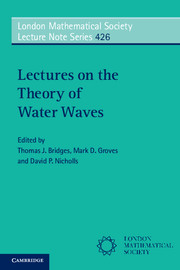Book contents
- Frontmatter
- Contents
- Contributors
- Preface
- 1 High-Order Perturbation of Surfaces Short Course: Boundary Value Problems
- 2 High-Order Perturbation of Surfaces Short Course: Traveling Water Waves
- 3 High-Order Perturbation of Surfaces Short Course: Analyticity Theory
- 4 High-Order Perturbation of Surfaces Short Course: Stability of Traveling Water Waves
- 5 A Novel Non-Local Formulation of Water Waves
- 6 The Dimension-Breaking Route to Three-Dimensional Solitary Gravity-Capillary Water Waves
- 7 Validity and Non-Validity of the Nonlinear Schrödinger Equation as a Model for Water Waves
- 8 Vortex Sheet Formulations and Initial Value Problems: Analysis and Computing
- 9 Wellposedness and Singularities of the WaterWave Equations
- 10 Conformal Mapping and Complex Topographies
- 11 Variational Water Wave Modelling: from Continuum to Experiment
- 12 Symmetry, Modulation, and Nonlinear Waves
- References
2 - High-Order Perturbation of Surfaces Short Course: Traveling Water Waves
Published online by Cambridge University Press: 05 February 2016
- Frontmatter
- Contents
- Contributors
- Preface
- 1 High-Order Perturbation of Surfaces Short Course: Boundary Value Problems
- 2 High-Order Perturbation of Surfaces Short Course: Traveling Water Waves
- 3 High-Order Perturbation of Surfaces Short Course: Analyticity Theory
- 4 High-Order Perturbation of Surfaces Short Course: Stability of Traveling Water Waves
- 5 A Novel Non-Local Formulation of Water Waves
- 6 The Dimension-Breaking Route to Three-Dimensional Solitary Gravity-Capillary Water Waves
- 7 Validity and Non-Validity of the Nonlinear Schrödinger Equation as a Model for Water Waves
- 8 Vortex Sheet Formulations and Initial Value Problems: Analysis and Computing
- 9 Wellposedness and Singularities of the WaterWave Equations
- 10 Conformal Mapping and Complex Topographies
- 11 Variational Water Wave Modelling: from Continuum to Experiment
- 12 Symmetry, Modulation, and Nonlinear Waves
- References
Summary
Abstract
In this contribution we discuss High-Order Perturbation of Surfaces (HOPS) methods with particular application to traveling water waves. The Transformed Field Expansion method (TFE) is discussed as a method for handling the unknown fluid domain. The procedures for computing Stokes waves and Wilton Ripples are compared. The Lyapunov-Schmidt procedure for the Wilton Ripple is presented explicitly in a simple, weakly nonlinear model equation.
Introduction
Traveling water waves have been studied for over a century, most famously by Stokes, for whom weakly-nonlinear periodic waves are now named [1–3]. In his 1847 paper, Stokes expanded the wave profile as a power series in a small parameter, the wave slope, a technique that has since become commonplace. This classic perturbation expansion, which we will refer to as the Stokes’ expansion, has been applied to the water wave problem numerous times [4–9]. When the effect of surface tension is included, the expansion may be singular. This singularity, due to a resonance between a long and a short wave, was noted first by Wilton [10] and has been studied more recently in [11–15].
In these lecture notes, we explain how traveling water waves may be computed using a High-Order Perturbation of Surfaces (HOPS) approach, which numerically computes the coefficients in an amplitude-based series expansion of the free surface. For the water wave problem, a crucial aspect of any numerical approach is the method used to handle the unknown fluid domain. Popular examples include Boundary Integral Methods [16, 17], conformal mappings [18, 19], and series computations of the Dirichelet-to-Neumann operator [20, 21]. Here we discuss an alternative approach, in which the solution is expanded using the Transformed Field Expansion (TFE) method, developed in [22, 23].
The TFE method has been used to compute traveling waves on both two-dimensional (one horizontal and one vertical dimension) and three-dimensional fluids, both for planar and short-crested waves [23]. Short-crested wave solutions to the potential flow equations have been computed without surface tension [22, 24, 25] and with surface tension [26]. They have also been studied experimentally [27, 28].
- Type
- Chapter
- Information
- Lectures on the Theory of Water Waves , pp. 19 - 31Publisher: Cambridge University PressPrint publication year: 2016
References
- 2
- Cited by



